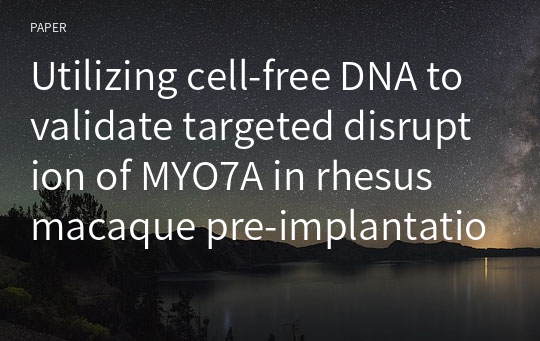Utilizing cell-free DNA to validate targeted disruption of MYO7A in rhesus macaque pre-implantation embryos
* 본 문서는 배포용으로 복사 및 편집이 불가합니다.
서지정보
ㆍ발행기관 : 한국수정란이식학회
ㆍ수록지정보 : Journal of Embryo Transfer / 37권 / 4호
ㆍ저자명 : Junghyun Ryu, Fernanda C Burch, Emily Mishler, Martha Neuringer, Jon D Hennebold, Carol Hanna
ㆍ저자명 : Junghyun Ryu, Fernanda C Burch, Emily Mishler, Martha Neuringer, Jon D Hennebold, Carol Hanna
목차
ABSTRACTINTRODUCTION
MATERIALS AND METHODS
RESULTS
DISCUSSION
REFERENCES
영어 초록
Direct injection of CRISPR/Cas9 into zygotes enables the production of genetically modified nonhuman primates (NHPs) essential for modeling specific human diseases, such as Usher syndrome, and for developing novel therapeutic strategies. Usher syndrome is a rare genetic disease that causes loss of hearing, retinal degeneration, and problems with balance, and is attributed to a mutation in MYO7A, a gene that encodes an uncommon myosin motor protein expressed in the inner ear and retinal photoreceptors. To produce an Usher syndrome type 1B (USH1B) rhesus macaque model, we disrupted the MYO7A gene in developing zygotes. Identification of appropriately edited MYO7A embryos for knockout embryo transfer requires sequence analysis of material recovered from a trophectoderm (TE) cell biopsy. However, the TE biopsy procedure is labor intensive and could adversely impact embryo development. Recent studies have reported using cell-free DNA (cfDNA) from embryo culture media to detect aneuploid embryos in human in vitro fertilization (IVF) clinics. The cfDNA is released from the embryo during cell division or cell death, suggesting that cfDNA may be a viable resource for sequence analysis. Moreover, cfDNA collection is not invasive to the embryo and does not require special tools or expertise. We hypothesized that selection of appropriate edited embryos could be performed by analyzing cfDNA for MYO7A editing in embryo culture medium, and that this method would be advantageous for the subsequent generation of genetically modified NHPs. The purpose of this experiment is to determine whether cfDNA can be used to identify the target gene mutation of CRISPR/Cas9 injected embryos. In this study, we were able to obtain and utilize cfDNA to confirm the mutagenesis of MYO7A, but the method will require further optimization to obtain better accuracy before it can replace the TE biopsy approach.참고 자료
없음"Journal of Embryo Transfer"의 다른 논문
 Effect of birth and lactation season on the growth of K..5페이지
Effect of birth and lactation season on the growth of K..5페이지 Development of an optimal protocol to induce capacitati..7페이지
Development of an optimal protocol to induce capacitati..7페이지 Degenerative changes in testis, epididymis, and sperm q..9페이지
Degenerative changes in testis, epididymis, and sperm q..9페이지 Heat stress effects on fertility and reproductive healt..10페이지
Heat stress effects on fertility and reproductive healt..10페이지 Analysis of cellular communication network factor (CCN)..11페이지
Analysis of cellular communication network factor (CCN)..11페이지 Enhancement of anti-inflammatory and anti-tumorigenic p..9페이지
Enhancement of anti-inflammatory and anti-tumorigenic p..9페이지 Cellular internalization effect of Ara27 in various cel..7페이지
Cellular internalization effect of Ara27 in various cel..7페이지 The antioxidant capacity of Mito-TEMPO improves the pre..8페이지
The antioxidant capacity of Mito-TEMPO improves the pre..8페이지 Embryo transfer of dorper breed to Mongolian sheep5페이지
Embryo transfer of dorper breed to Mongolian sheep5페이지 Palmitic acid induces inflammatory cytokines and regula..8페이지
Palmitic acid induces inflammatory cytokines and regula..8페이지


























